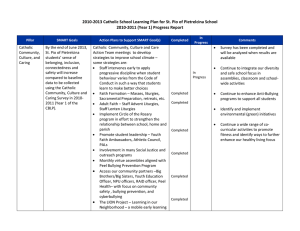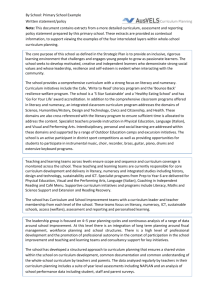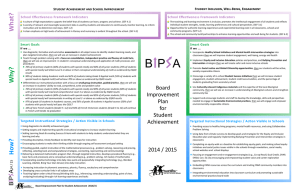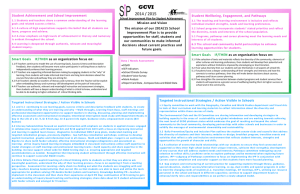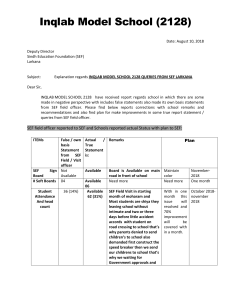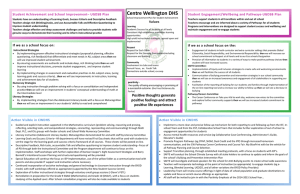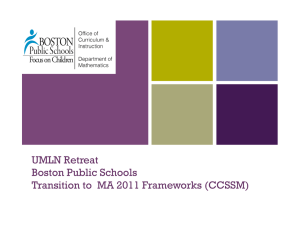Document 10454938
advertisement
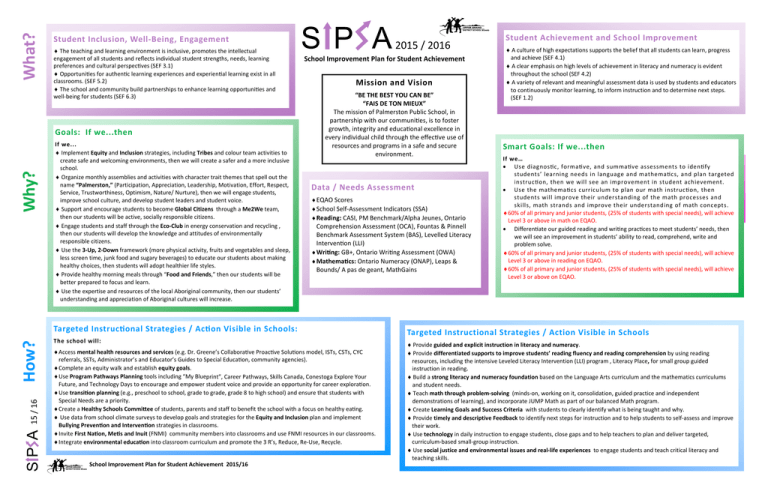
What? Student Inclusion, Well‐Being, Engagement The teaching and learning environment is inclusive, promotes the intellectual engagement of all students and reflects individual student strengths, needs, learning preferences and cultural perspec ves (SEF 3.1) Opportuni es for authen c learning experiences and experien al learning exist in all classrooms. (SEF 5.2) The school and community build partnerships to enhance learning opportuni es and well‐being for students (SEF 6.3) Why? S P A Goals: If we...then If we... Implement Equity and Inclusion strategies, including Tribes and colour team activities to create safe and welcoming environments, then we will create a safer and a more inclusive school. Organize monthly assemblies and activities with character trait themes that spell out the name “Palmerston,” (Participation, Appreciation, Leadership, Motivation, Effort, Respect, Service, Trustworthiness, Optimism, Nature/ Nurture), then we will engage students, improve school culture, and develop student leaders and student voice. Support and encourage students to become Global Citizens through a Me2We team, then our students will be active, socially responsible citizens. Engage students and staff through the Eco‐Club in energy conservation and recycling , then our students will develop the knowledge and attitudes of environmentally responsible citizens. Use the 3‐Up, 2‐Down framework (more physical activity, fruits and vegetables and sleep, less screen time, junk food and sugary beverages) to educate our students about making healthy choices, then students will adopt healthier life styles. Provide healthy morning meals through “Food and Friends,” then our students will be better prepared to focus and learn. Use the expertise and resources of the local Aboriginal community, then our students’ understanding and appreciation of Aboriginal cultures will increase. How? 15 / 16 SP A 2015 / 2016 Mission and Vision “BE THE BEST YOU CAN BE” “FAIS DE TON MIEUX” The mission of Palmerston Public School, in partnership with our communi es, is to foster growth, integrity and educa onal excellence in every individual child through the effec ve use of resources and programs in a safe and secure environment. Data / Needs Assessment EQAO Scores School Self‐Assessment Indicators (SSA) Reading: CASI, PM Benchmark/Alpha Jeunes, Ontario Comprehension Assessment (OCA), Fountas & Pinnell Benchmark Assessment System (BAS), Levelled Literacy Interven on (LLI) Wri ng: GB+, Ontario Wri ng Assessment (OWA) Mathema cs: Ontario Numeracy (ONAP), Leaps & Bounds/ A pas de geant, MathGains The school will: Access mental health resources and services (e.g. Dr. Greene’s Collabora ve Proac ve Solu ons model, ISTs, CSTs, CYC referrals, SSTs, Administrator’s and Educator’s Guides to Special Educa on, community agencies). Complete an equity walk and establish equity goals. Use Program Pathways Planning tools including “My Blueprint”, Career Pathways, Skills Canada, Conestoga Explore Your Future, and Technology Days to encourage and empower student voice and provide an opportunity for career explora on. Use transi on planning (e.g., preschool to school, grade to grade, grade 8 to high school) and ensure that students with Special Needs are a priority. Create a Healthy Schools Commi ee of students, parents and staff to benefit the school with a focus on healthy ea ng. Use data from school climate surveys to develop goals and strategies for the Equity and Inclusion plan and implement Bullying Preven on and Interven on strategies in classrooms. Invite First Na on, Me s and Inuit (FNMI) community members into classrooms and use FNMI resources in our classrooms. Integrate environmental educa on into classroom curriculum and promote the 3 R’s, Reduce, Re‐Use, Recycle. Student Achievement and School Improvement A culture of high expectations supports the belief that all students can learn, progress and achieve (SEF 4.1) A clear emphasis on high levels of achievement in literacy and numeracy is evident throughout the school (SEF 4.2) A variety of relevant and meaningful assessment data is used by students and educators to continuously monitor learning, to inform instruction and to determine next steps. (SEF 1.2) School Improvement Plan for Student Achievement Targeted Instruc onal Strategies / Ac on Visible in Schools: School Improvement Plan for Student Achievement 2015/16 Smart Goals: If we...then If we… Use diagnos c, forma ve, and summa ve assessments to iden fy Student Wellbeing, Engagement, and Pathways students’ learning needs in language and mathema cs, and plan targeted (from your SSA results) instruc on, then we will see an improvement in student achievement. Use the mathema cs curriculum to plan our math instruc on, then students will improve their understanding of the math processes and skills, math strands and improve their understanding of math concepts. 60% of all primary and junior students, (25% of students with special needs), will achieve Level 3 or above in math on EQAO. Differen ate our guided reading and wri ng prac ces to meet students’ needs, then we will see an improvement in students’ ability to read, comprehend, write and problem solve. 60% of all primary and junior students, (25% of students with special needs), will achieve Level 3 or above in reading on EQAO. 60% of all primary and junior students, (25% of students with special needs), will achieve Level 3 or above on EQAO. Targeted Instructional Strategies / Action Visible in Schools Provide guided and explicit instruction in literacy and numeracy. Provide differentiated supports to improve students’ reading fluency and reading comprehension by using reading resources, including the intensive Leveled Literacy Intervention (LLI) program , Literacy Place, for small group guided instruction in reading. Build a strong literacy and numeracy foundation based on the Language Arts curriculum and the mathematics curriculums and student needs. Teach math through problem‐solving (minds‐on, working on it, consolidation, guided practice and independent demonstrations of learning), and incorporate JUMP Math as part of our balanced Math program. Create Learning Goals and Success Criteria with students to clearly identify what is being taught and why. Provide timely and descriptive Feedback to identify next steps for instruction and to help students to self‐assess and improve their work. Use technology in daily instruction to engage students, close gaps and to help teachers to plan and deliver targeted, curriculum‐based small‐group instruction. Use social justice and environmental issues and real‐life experiences to engage students and teach critical literacy and teaching skills.
